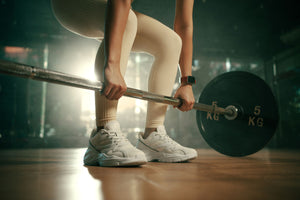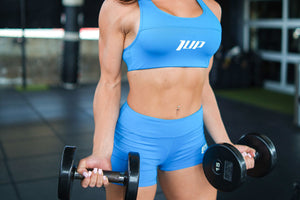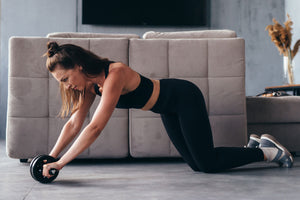Spend enough years training, and you’re bound to accumulate your fair share of bumps, bruises, tweaks, and achy joints.
And as a result, some of the exercises you relied on to build muscle and lose fat initially (squat, bench, deadlift, etc.), may not be a good fit for your body at this time in your training career.
But, just because you can’t perform one or two specific variations of an exercise doesn’t mean you have to stop training altogether.
Here, we present our favorite joint-friendly exercises that you can incorporate into your own training whenever you’re dealing with aches and pains in a particular area.
Even if you’re not dealing with any injuries, you can also swap any of these exercise variations into your current training program as a way to spice things up and help avoid plateaus.
Top 9 Joint-Friendly Exercises
Landmine Shoulder Press
One of the most well-known joint-friendly exercises has to be the landmine shoulder press. It’s a great upper body pressing exercise to train the chest, shoulders and triceps for those who may experience pain or discomfort from flat barbell presses or military presses.
Doing so will promote scapular stability so that your rotator cuff muscles will have strong bases of support in a tight upper back.
The reason the landmine shoulder press is a great exercise for those with shoulder issues is that it allows for natural movement of the scapula (as opposed to a bench press where it is fixed in place), stimulates the muscles that surround the shoulder blade and help secure it in place along the rib cage. This creates a more stable base from which to press and helps reduce stress on the shoulder joint.
The landmine shoulder press is also a great alternative for those who have trouble getting their arms completely overhead without excessively arching or rounding their backs. Due to the 45-degree angle of pressing, the landmine allows you to press through a full range of motion without hyperextending your lower back.
Finally, due to the neutral grip used for the exercise, the landmine press also places the shoulders and elbows in a more favorable position to press as opposed to the pronated grip used during convention military presses.
Low Incline Dumbbell Press
The barbell bench press is a staple upper body exercise for men and women alike, but it’s not always the most friendly to the shoulders and elbows, due to the potential for internal rotation that can occur at the shoulder joint.
The slight elevation above parallel allows the chest to take on more of the force, sparing the shoulders. And, the low incline dumbbell press also helps target the fibers of the upper chest, which is underdeveloped in most gym rats.
The use of dumbbells allows you to bring your elbows closer in to your body as well as the ability to use a more neutral or hammer (palms facing each other) grip. This helps relieve pressure on the shoulder capsule and elbows, by placing them in a more favorable position from which to press.
Box Squats
At the first sign of knee pain during squats, many lifters abandon the exercise altogether in lieu of a combination of leg presses and leg extensions. But, just because traditional barbell back squats may not be jiving with your body at the moment, doesn’t mean you can’t squat at all.
Enter the box squat, a squat variation where (you guessed it) you squat down to a box.
The box squat is an attractive option for those working around knee issues as it allows you to keep a vertical shin angle, which prevents the knees from tracking too far forward during the squat, reducing shear stress and pain at the knee joint.
The box squat also helps recruit the muscles of the posterior chain (glutes and hamstrings) more due to having to sit down and back on the box squat. This is important as most lifters tend to be quad-dominant, so any extra posterior chain work is always welcome!
Finally, box squats also force you to remain tight at the bottom of the movement. It can be common for lifters to get “loose” in the bottom of a traditional back squat, which puts added stress on the knees. Box squats help reinforce the notion of keeping things tight throughout the range of motion, further helping reduce knee pain.
Reverse Lunges
The walking (or forward) lunge is a staple leg exercise for those looking to build stronger glutes and firmer thighs. And, while it is an effective quad exercise, it can also place a lot of shear stress on the knee joint.
For those looking to get the benefits of lunging, but want to avoid the potential knee pain involved with walking lunges, the reverse lunge offers a phenomenal way to train the legs and spare your knees at the same time.
Similar to the box squat above, the reverse lunge allows you to maintain a mostly vertical shin angle. Additionally, since your stepping backward in a reverse lunge as opposed to lunging forward (where your momentum is driven forward directly onto your knee), a lot less stress is loaded onto the knee joint.
The reverse lunge also recruits more glute and hamstring than a forward lunge. And, as we mentioned above, this is a very beneficial thing as most lifters have an imbalance between the strength of their quads and hamstrings (which heightens the risk for knee pain and injury).
Sled Pulls
If you’ve got chronically achy knees and the thought of any type of squat or lunge sends shivers down your spine, sled pulls offer another joint-friendly way to train the legs as they are both knee and lower-back friendly.
Sled pulls are also a great exercise for rehabbing a knee injury as it helps strengthen terminal knee extension (TKE). This is a great way to blast your quads if you have knee problems and can't do squats, lunges, or leg extensions. It's also a valuable exercise for knee rehab, thanks to the terminal knee-extension action it requires.
Dumbbell Squeeze Floor Press
Effectively training the triceps can become difficult when you’re dealing with cranky elbows as seemingly every type of kickback, pushdown, or overhead extension bugs your elbows. Close grip barbell presses are also a no go for many people as in addition to irritating the elbow the exercise also aggravates the shoulders.
That’s where the dumbbell floor press comes in.
By pressing from the floor, you’re limiting the amount of extension that occurs at the shoulder joint, which reduces stress on it. When performed with dumbbells (or a football bar) the floor press also means you’re using neutral or hammer grip which further reduces strain on both shoulders and elbows, allowing for powerful and complete contraction of the triceps, with less stress placed on the elbow joint.
The floor press also offers another great option to train the chest for those bothered by the traditional bench press.
Hammer Curl & Reverse-Grip Curls
Next to shoulder pain, elbow pain is the next most common source of joint pain amongst lifters, and pain in and around the elbows can make any type of upper body exercise (pull-ups, rows, dips, etc), uncomfortable. However, the elbow joint itself is rarely the cause of joint pain, it’s usually the result of an imbalance between the forearm flexors and extensors that causes the elbow to feel pain.
One of the most common exercises that lifters experience elbow pain is barbell curls. The reason many lifters get elbow pain from barbell curls (or barbell exercises in general) is that your arms are locked into one movement path, and excessive repetition of the same movement pattern can lead to overuse injuries like tendonitis.
Using dumbbells allows you to vary your grip and range of motion to accommodate your own individual biomechanics.
Chest-Supported Incline Dumbbell Row
Barbell rows are a great exercise for developing the muscles of the upper back, but most lifters cannot perform them with proper form. They either allow their low backs to round (increasing their chance of injury) or use a lot of heaving and hoping to pull the weight up. Either way, you’re not really getting the most out of this exercise. And at worse, you’re placing yourself at undue risk of injury.
The incline dumbbell row (or seal row) is a great back exercise for those who are bothered by low back pain during traditional bent over rows.
Since your body is supported by the bench, loading on the spine and low back are significantly reduced. This is important (especially if you’re doing heavy deadlifts) as too many lower-back intensive exercises in a workout can really take a toll on your ability to recover sufficiently from one exercise to the next or from one workout to another.
Additionally, the use of a neutral grip allows for less irritation on the shoulders, wrists and elbows, making it a double friendly exercise to train the back while sparing your joints.
Trap Bar Deadlift
When it comes to all around muscle and strength builders, few exercises are as effective as the barbell deadlift. However, due to individual biomechanics or injury history, conventional deadlifts may not be suitable for every lifter.
Trap bar deadlifts allow you to still deadlift but with less chance for low back and shoulder strain. The reason for this is that the trap bar deadlift uses neutral grip handles that are slightly higher, making it easier to get into position for the lift compared to conventional deadlifts. This is especially helpful for taller lifters who struggle to get low enough to pull the barbell without rounding their back due to a lack of mobility and flexibility.
Trap bar deadlifts also help keep a more upright torso and allow for deeper knee flexion, which places less stress on the lower back.
Glute Bridges / Hip Thrusts
Glute bridges are an excellent exercise for strengthening the glutes, hips, hamstrings, and abs while placing minimal pressure on the knees and hips.
If bodyweight glute bridges are too easy for you, you can progress to single-leg bridges, single-leg bridge kicks, holding a dumbbell on your hips, or switching over to the weighted hip thrust which is essentially a glute bridge with a barbell laid across your hips.
It’s important when performing glute bridges to maintain a tight core and push through the heels while being mindful not to hyperextend the back at the top of the movement or allow the low back to round at the bottom of the movement. Focus on squeezing the glutes as hard as possible at the top and pausing for a full second before lowering to ensure complete engagement of the glutes. Make sure to checkout this blog article "Why Joint and Cartilage Recovery is so Important?"






